
views
X
Research source
Searching the Internet
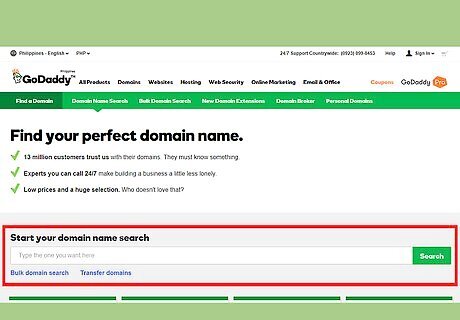
Check the availability of the domain. You can search at any domain registrar to see if a domain name related to a trademark or other word or phrase associated with your business is available as a domain name. Domain registrars typically allow you to search a domain and see if it is available for free. If it is available, you can choose pricing options to register the domain for yourself or in the name of your business. Make sure to check availability across other top-level domains. The search may default to ".com," the most common top-level domain, but you also typically want to make sure the name isn't being used as a .net, a .org, or a .biz. There are a number of other top-level domains, so check all the ones that you think have relevance to your business. If the word or phrase you want is already in use, make a note of it so you can find out the identity of the current domain holder. You may want to go ahead and register any domains you've searched that are available, just to avoid having to repeat this process later.
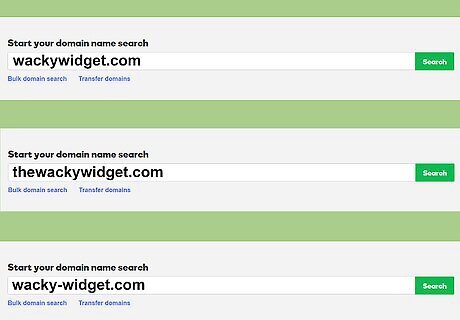
Look at similar domains. In addition to domains that include the exact word or phrase you want to use, you also should consider other names a customer might use, or something that could appear in an internet search and confuse customers into thinking it was you. Cybersquatters often register domains that are confusingly similar to the word or phrase for which you have a registered trademark. Try to brainstorm small changes or augmentations that are related to your trademarked word or phrase. For example, if you sell a product called "Wacky Widget," you might look for domains such as "thewackywidget.com" and "wacky-widget.com" in addition to "wackywidget.com." Don't forget to expand your search to other top-level domains. You want to lock down as many of these variations as possible for a few reasons. Primarily, if that domain has a stronger history and value, it may come up before your actual site in search engine results. Customers may mistakenly believe it is your website. Additionally, if cybersquatters registered that domain, they did so to syphon off traffic intended for you to make money off of the ads they placed on the site. If you own these variations, you can set them to redirect to your primary site, capturing more traffic and more potential customers.

Consider common typos. Cybersquatters don't just sit on domains that actually contain trademarked words or phrases. They also claim domains with the letters of a trademarked word or phrase transposed, which customers may reach in error if they type quickly. Particular cybersquatters, also called typosquatters, take advantage of quick and careless typing to register domain names that match what someone might accidentally type when they were trying to search for your trademark. Transpositions of letters are common (such as "wacky widget" or "wacky widget" instead of "wacky widget"), as well as mistakes that involve hitting the letter next to the one intended on the keyboard. You'll have a hard time trying to capture every possible typo domain, but glance at the keyboard and try to come up with some. Another way to find some common typos is to type your word or phrase as fast as you can over and over without looking. You're bound to make a mistake eventually, and when you do, search that mistake at a registrar to see if the domain is registered. If they're available, you can register these domains too if you want and save yourself some potential hassle later. However, they're not something you need to worry about too much as long as nobody's registered them.
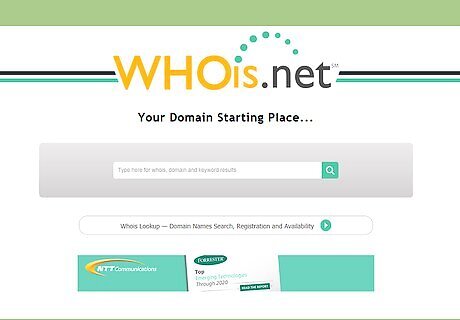
Use the WHOIS utility. WHOIS provides a name and contact information for the person or business who has currently registered the domain you want. You can access the utility online at www.whois.net. Type the exact web address into the box provided, and follow the instructions on the site. Your search will return the name of the current domain holder as well as administrative, technical, and billing contact information. You also can find out when the domain was originally registered and when that registration is due to expire. Domain holders may have contracted with their registrar for domain name privacy, which means their actual names and contact information will be withheld. Instead, the name of a domain privacy company or registrar will be listed. If you see a domain privacy company or registrar listed as the owner of the domain, you'll have to go through them to get contact information for the registered owner.
Examining Intent
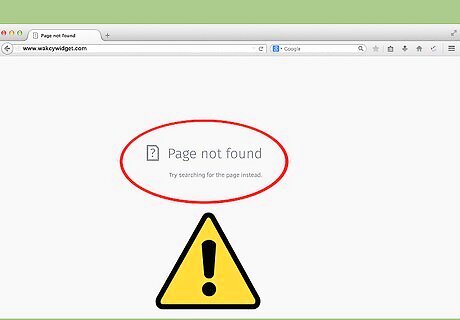
Visit the website. The quickest way to determine whether the person who currently owns the domain you want to use is a legitimate business owner or a cybersquatter is to visit the website located at that domain, if it's currently active. Type the name into your address bar and see what comes up. If the site is nothing but a bunch of display ads and pop-ups, it probably has been set up by a cybersquatter. If there's nothing at that address – you got a notice that your browser couldn't find the server, or there's a blank or nearly blank page that says the site is under development or the like – it also may have been set up by a cybersquatter. However, check the date when the domain was registered from the information you got in your WHOIS search. It may be that the registered owner just purchased the domain and hasn't set their website up yet. If the address leads to what appears to be an actual website developed for a real business, take a few minutes to poke around the site and get to know the owner and his or her business. A site that appears to be a legitimate business site at first blush may reveal itself to be nothing more than a holding page for cybersquatters after you spend a little time on it.

Send the domain holder a letter. Using the contact information you got from the WHOIS utility, draft an exploratory business letter to the domain holder that expresses your interest in purchasing the domain from them. Your letter should follow standard business format, using polite and professional language. Introduce yourself and explain your purpose for writing in the first paragraph. Avoid giving too much personal or background information about yourself or your business, or talking about why you are interested in the domain. You don't want to appear too attached, because that tells the current domain holder they can potentially extract more money from you. If you gleaned any information from your perusal of the website, use it in your letter. Mention your trademark and attach a copy of your trademark registration. Introduce some urgency by telling them that you have a deadline, or that your boss is on your back to complete the transaction quickly. It doesn't matter if any of that is true, because it's not anything the domain holder could ever find out about. Give them a low-ball offer to transfer the domain to you, and provide a deadline for a response. Mail your letter using certified mail with returned receipt requested so you know when they get it.
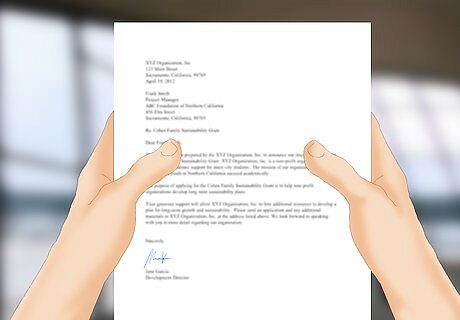
Evaluate the domain holder's response. Typically the response you receive from the domain holder will let you know for sure if they are a cybersquatter or simply a business owner who is inadvertently using a domain name that potentially infringes your trademark. An innocent business owner may accept your offer straight-up, or may try to negotiate with you a little, but you shouldn't have to pay too much money to get the domain in your name. A cybersquatter, on the other hand, is going to try to squeeze the maximum value for the domain. Keep in mind that this is their business, however dishonest it may be. If you are dealing with a cybersquatter, you typically will have a difficult time negotiating them down to a price you're willing to pay. You may want to consult an attorney and find out what other options are available to get rid of them. At the same time, it still often is in your best interests financially to attempt to negotiate privately with a cybersquatter rather than filing a domain name dispute complaint or a lawsuit for trademark infringement, since those options can end up costing you thousands of dollars as well as taking months – if not years – to resolve.
Eliminating Cybersquatters
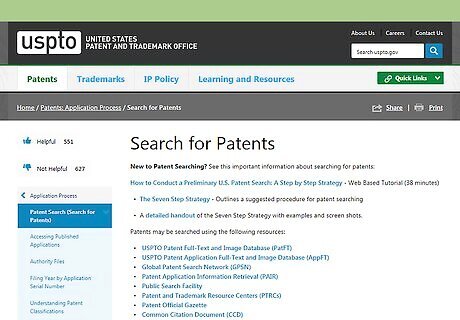
Register your trademarks. If you haven't already registered trademarks in the names, words, and phrases that you use in connection with your business, doing so gives you additional legal means to shut down cybersquatters. You must conduct a search of the USPTO's database to ensure the word or phrase you want to trademark isn't already registered. The USPTO has a searchable database on its website that includes all active registrations as well as pending applications and abandoned marks. Trademark applications can be complicated, so if you intend to register trademarks you should consider hiring a trademark attorney to smooth the process and ensure your application is completed correctly. Keep in mind that your application will be reviewed by a USPTO attorney, so it makes sense to have an attorney on your side as well. Generally, you can't file a lawsuit in federal court to get rid of a cybersquatter unless the domain involves a registered trademark.
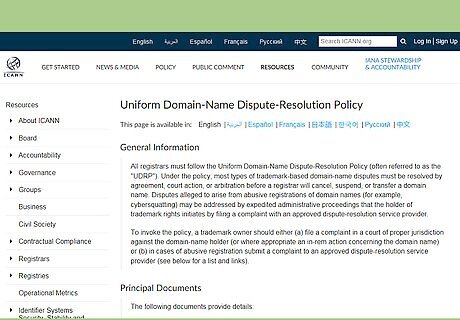
File a UDRP complaint. The Uniform Dispute Resolution Policy (UDRP) provides a mechanism to resolve domain name disputes using binding arbitration. The fees and specific procedures depend on which arbitration provider you choose. You can download and read the UDRP by visiting the website of the Internet Corporation for Assigned Names and Numbers (ICANN). To file a complaint under the UDRP, you must have information about your trademark as well as information about the individual who originally registered the domain. You must choose an arbitration provider from four ICANN-approved organizations, including the World Intellectual Property Organization (WIPO) and the National Arbitration Forum (NAF). Each arbitration provider has its own supplemental rules that govern the complaint itself, the arbitration procedures, and the fees for dispute resolution services. Filing a UDRP complaint can bring resolution much faster than filing a lawsuit, since the arbitration panel typically reaches a decision within a few months of the date you file your complaint.
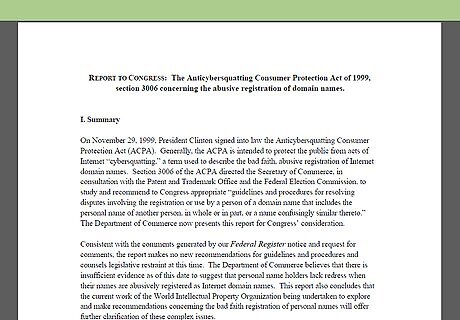
File a lawsuit. If you have a registered trademark, you can file a lawsuit in federal court alleging that the current domain holder has infringed your trademark by registering that domain. You also may have recourse under the federal Anticybersquatting Consumer Protection Act if you can show the current domain holder acted in bad faith. Due to the complexity of federal law in this area, as well as federal court rules and procedures, hiring an experienced intellectual property litigation attorney is essential if you have to sue the cybersquatter to get rid of them. Your attorney will work with you to build the allegations that will form the bulk of your complaint, calculate damages, and file the complaint with the federal district court that has jurisdiction over your case. You can expect litigation and discovery to take months, if not years. Keep in mind that if you file a lawsuit against a cybersquatter, it may be several years before the domain is relinquished to your control.

Create a robust domain defense program. Practicing domain defense in your business by preemptively purchasing domains similar to your trademarks and using a service to monitor the internet for potentially infringing domains can prevent future problems with cybersquatters. Domain purchase is one of the most cost-effective ways to defend against cybersquatters. Domain registration is relatively cheap – especially compared to the thousands of dollars and months of effort it can take to get rid of a cybersquatter through a lawsuit. Large corporations typically maintain portfolios containing thousands of domain names that would either be potentially misleading to customers or would infringe on their trademarks. You also might want to check into a subscription service that will continually monitor the internet for cybersquatters as well as confusingly similar websites that could potentially harm your business standing or your reputation with customers.




















Comments
0 comment